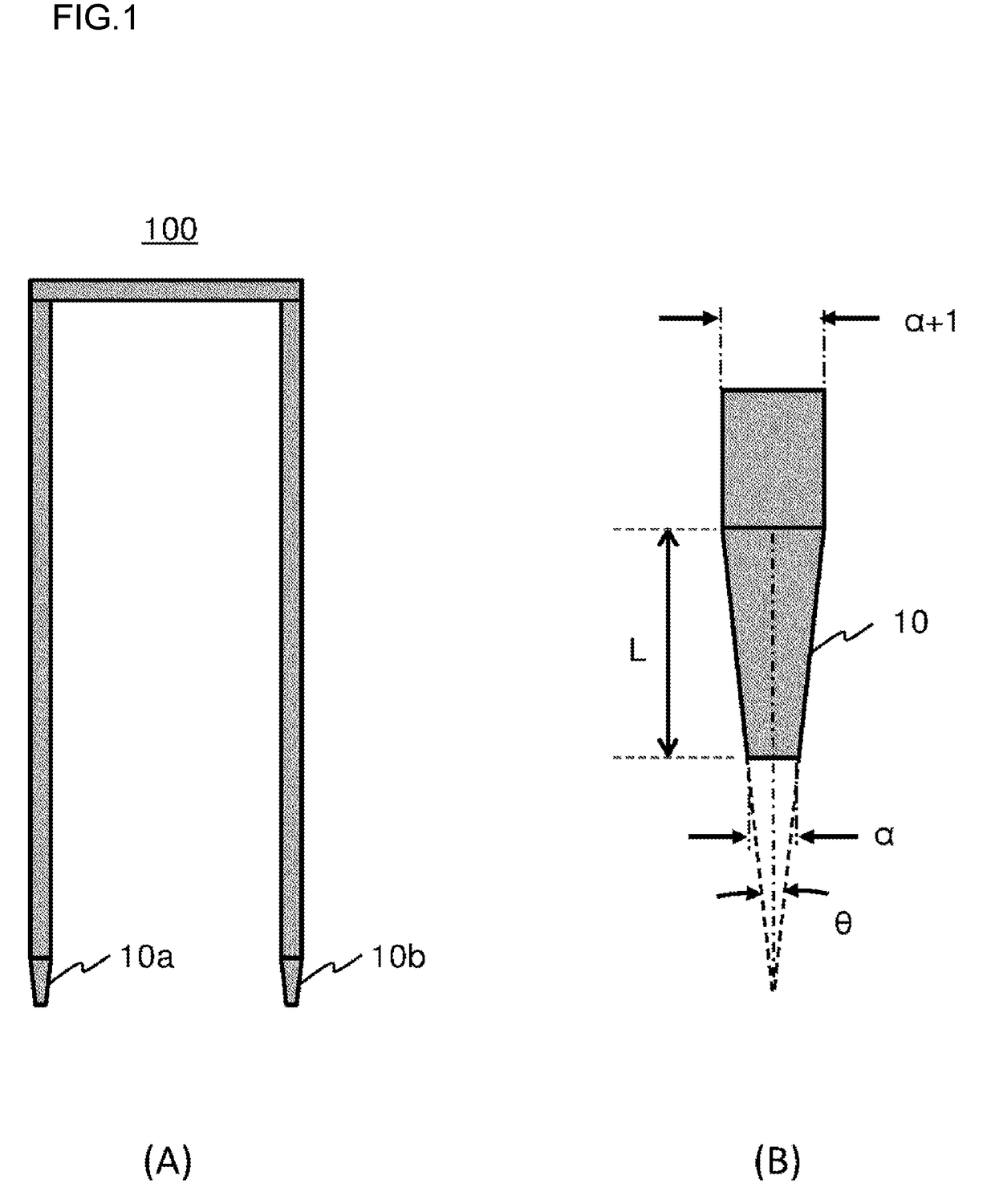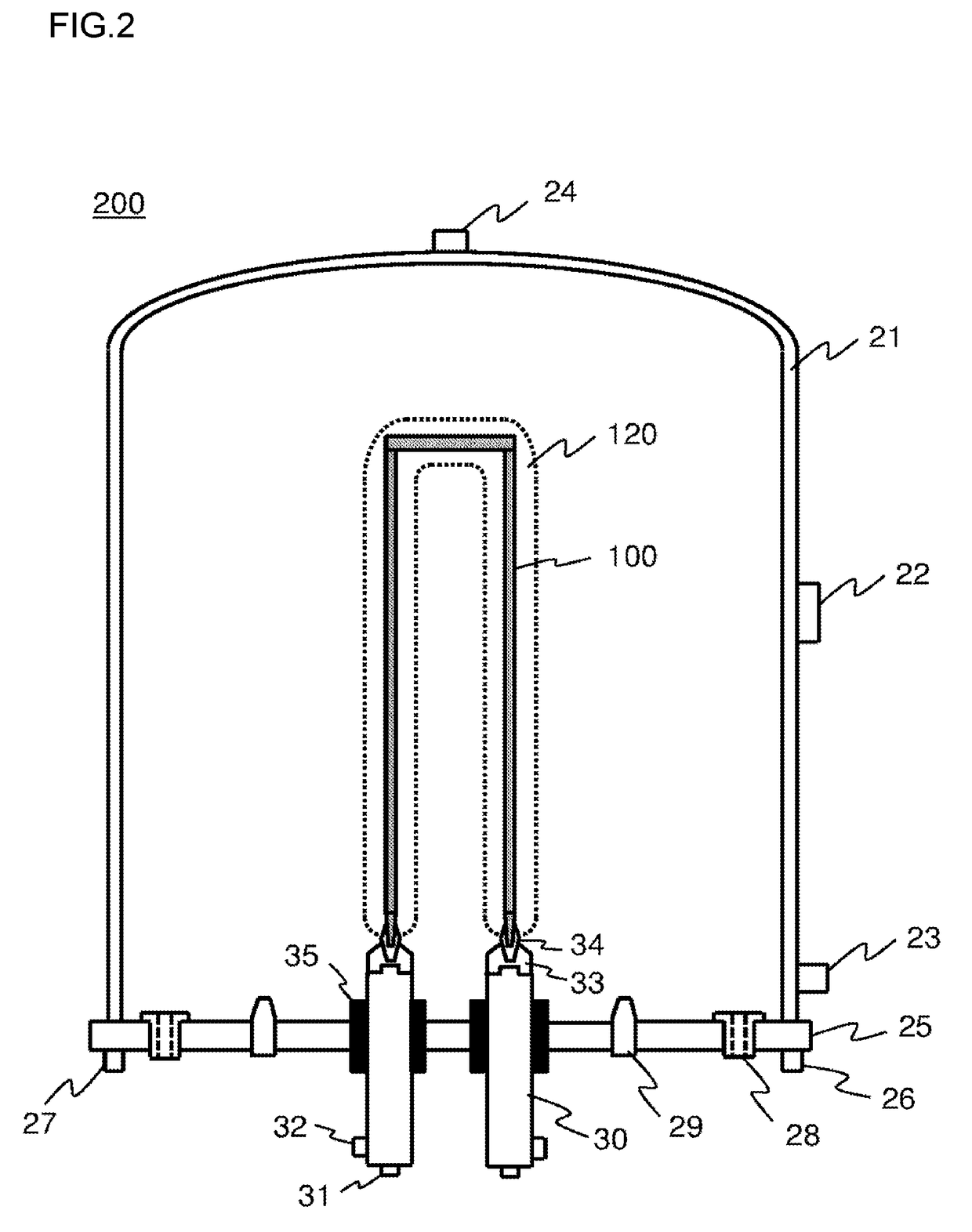Silicon core wire for producing polycrystalline silicon rod, and device for producing polycrystalline silicon rod
a technology of polycrystalline silicon and core wire, which is applied in the direction of chemical/physical/physical-chemical processes, inorganic chemistry, chemical/physical/physical-chemical processes, etc., can solve the problems of complex structure of holding member (graphite chuck), remarkably reduced mutual connection strength, and silicon core wire falling. , to achieve the effect of preventing the failure of silicon core wire and reducing contact resistan
- Summary
- Abstract
- Description
- Claims
- Application Information
AI Technical Summary
Benefits of technology
Problems solved by technology
Method used
Image
Examples
example 1
[0078]In the form illustrated in FIG. 3, a silicon core wire 100 was set in a reaction furnace 200. The height (length) of the silicon core wire 100 was 1,850 mm; and the cross-section had a rectangle whose one side was 7 mm. The end part 10 of the silicon core wire 100 was provided with a tapered part whose taper was 1 / 50 (taper angle: 1.1459°) and taper length was 45 mm.
[0079]The cross-section of an opening part of a core wire holder 34 to accommodate the end part 10 of the silicon core wire 100 was made to be a rectangle; the opening part is processed into a taper shape whose taper was 1 / 50 (taper angle: 1.1459°) and taper length was 40 mm; and the silicon core wire 100 resulted in being held by its own weight.
[0080]After the interior of the reaction furnace 200 was replaced by hydrogen, a voltage of 2,000 V was applied to the silicon core wire 100, which was thus energized (ignited). Thereafter, a raw material gas in which trichlorosilane was diluted with hydrogen was supplied i...
example 2
[0082]The production of 10 batches of a polycrystalline silicon rod 120 of 45 mm in diameter was carried out under the same condition as in Example 1, except for causing polycrystalline silicons to deposit at a deposition rate of 15 μm / min, and there were observed no local fusion of or structural damage to the silicon core wires due to generation of sparks and the like, and no falling nor failure of the silicon core wires 100.
example 3
[0087]In the form illustrated in FIG. 3, a silicon core wire 100 was set in a reaction furnace 200. The height (length) of the silicon core wire 100 was 2,000 mm; and the cross-section had a rectangle whose one side was 7 mm. The end part 10 of the silicon core wire 100 was provided with a tapered part whose taper was 1 / 50 (taper angle: 1.1459°) and taper length was 45 mm.
[0088]The cross-section of an opening part of a core wire holder 34 to accommodate the end part 10 of the silicon core wire 100 was made to be a rectangle; the opening part is processed into a taper shape whose taper was 1 / 50 (taper angle: 1.1459°) and taper length was 45 mm; and the silicon core wire 100 resulted in being held by its own weight.
[0089]After the interior of the reaction furnace 200 was replaced by hydrogen, a voltage of 2,000 V was applied to the silicon core wire 100, which was thus energized (ignited). Thereafter, a raw material gas in which trichlorosilane was diluted with hydrogen was supplied i...
PUM
| Property | Measurement | Unit |
|---|---|---|
| taper length | aaaaa | aaaaa |
| taper length | aaaaa | aaaaa |
| taper angle | aaaaa | aaaaa |
Abstract
Description
Claims
Application Information
 Login to View More
Login to View More - R&D
- Intellectual Property
- Life Sciences
- Materials
- Tech Scout
- Unparalleled Data Quality
- Higher Quality Content
- 60% Fewer Hallucinations
Browse by: Latest US Patents, China's latest patents, Technical Efficacy Thesaurus, Application Domain, Technology Topic, Popular Technical Reports.
© 2025 PatSnap. All rights reserved.Legal|Privacy policy|Modern Slavery Act Transparency Statement|Sitemap|About US| Contact US: help@patsnap.com



